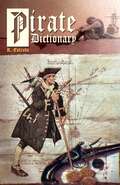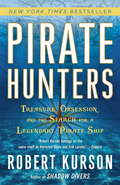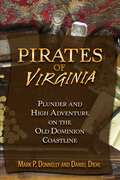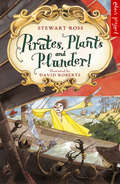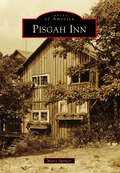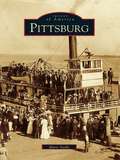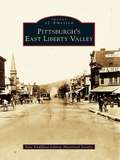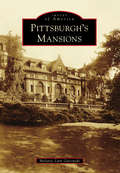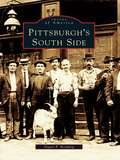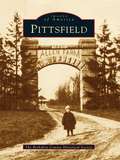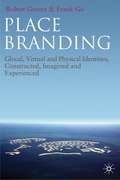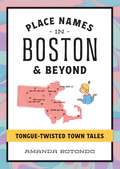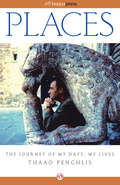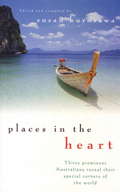- Table View
- List View
Piracy, Turtles and Flying Foxes (Great Journeys Ser.)
by William DampierDampier's (1651-1715) adventures and writing inspired both Robinson Crusoe and Gulliver's Travels, but in his own right he was a remarkable, observant and enjoyable writer - whether on a woefully mishandled pirate raid in Spanish America or on a desperate journey to Sumatra in an open boat or on the habits of manatees or bats. He also left the first description in English of the Aborigines of Australia - thus initiating a painful, now three centuries' long encounter between peoples on opposite sides of the world.Great Journeys allows readers to travel both around the planet and back through the centuries – but also back into ideas and worlds frightening, ruthless and cruel in different ways from our own. Few reading experiences can begin to match that of engaging with writers who saw astounding things: Great civilisations, walls of ice, violent and implacable jungles, deserts and mountains, multitudes of birds and flowers new to science. Reading these books is to see the world afresh, to rediscover a time when many cultures were quite strange to each other, where legends and stories were treated as facts and in which so much was still to be discovered.
Pirate Dictionary
by Rafael EstradaCompilation of famous pirates and nautical terms. Did you know that Bartolomew Roberts was a distinguished, elegant and courteous pirate, music lover, teetotaler and that he did not allow gambling with money or duels on board...? That when Blackbeard went to combat, he placed hemp wicks soaked in saltpeter, lit under his fur hat, in order to appear surrounded by black smoke and cause terror...? Do you know the difference between a pirate, a buccaneer, a privateer and a filibuster...? Would you distinguish a cutlass from a saber...? This book contains all the documentation that I used to write the novel THE CIRCULAR PIRATES. Sorted in dictionary format for easy searching, it is an excellent source for authors who wish to embark on the wonderful adventure of writing a pirate story.
Pirate Hunters
by Robert KursonA thrilling new adventure of danger and deep-sea diving, historic mystery and suspense, by the author of the New York Times bestseller Shadow Divers Finding and identifying a pirate ship is the hardest thing to do under the sea. But two men--John Chatterton and John Mattera--are willing to risk everything to find the Golden Fleece, the ship of the infamous pirate Joseph Bannister. At large during the Golden Age of Piracy in the seventeenth century, Bannister should have been immortalized in the lore of the sea--his exploits more notorious than Blackbeard's, more daring than Kidd's. But his story, and his ship, have been lost to time. If Chatterton and Mattera succeed, they will make history--it will be just the second time ever that a pirate ship has been discovered and positively identified. Soon, however, they realize that cutting-edge technology and a willingness to lose everything aren't enough to track down Bannister's ship. They must travel the globe in search of historic documents and accounts of the great pirate's exploits, face down dangerous rivals, battle the tides of nations and governments and experts. But it's only when they learn to think and act like pirates--like Bannister--that they become able to go where no pirate hunters have gone before. Fast-paced and filled with suspense, fascinating characters, history, and adventure, Pirate Hunters is an unputdownable story that goes deep to discover truths and souls long believed lost.Advance praise for Pirate Hunters "A great thriller full of tough guys and long odds . . . and: It's all true."--Lee Child "Action and adventure on land and sea--you can't ask for more. But Robert Kurson raises the ante in Pirate Hunters with an array of mystery and a fleet of colorful characters spanning four centuries. This is a great summer read!"--Michael Connelly "Pirate Hunters is a fantastic book, an utterly engrossing and satisfying read. It tells the story of the hunt for the rare wreck of a pirate ship, which had been captained by one of the most remarkable pirates in history. This is a real-life Treasure Island, complete with swashbuckling, half-crazy treasure hunters and vivid Caribbean settings--a story for the ages."--Douglas Preston "A terrific read. I was pulled in from page one. Kurson brings us face to face with some of the most swashbuckling pirates ever to sail the Caribbean, even as he takes us underwater on a high-tech quest to discover the relics they left behind."--Daniel James Brown "There's nothing in the world like buried treasure--and people hungry and obsessed enough to risk their lives for it. Pirate Hunters isn't just a good story--it's a true one. Searching for the souls of its explorers, it takes you to the far tip of the plank and plunges you deep to the bottom of the ocean."--Brad Meltzer "Pirate Hunters is a gripping account of two courageous divers' quest to uncover the shipwrecked vessel of Joseph Bannister, one of history's most infamous pirates. Robert Kurson will keep you on the edge of your seat in this high-stakes journey around the globe that ultimately teaches these explorers about much more than an old ship."--Sen. John McCain "Kurson's own enthusiasm, combined with his copious research and an eye for detail, makes for one of the most mind-blowing pirate stories of recent memory."--Publishers Weekly (starred review)From the Hardcover edition.
Pirates of Virginia
by Mark P. Donnelly Daniel DiehlHigh adventure, dastardly deeds, and newly uncovered lore.
Pirates, Plants And Plunder!
by Stewart RossTwelve fascinating tales about the adventurers who travelled all over the globe, finding new plants and the amazing things they produce. Join Joseph Banks as he gets stranded on the Australian Great Barrier Reef whilst searching for new botanical specimens. Battle with the Mexican Emperor Montezuma against the invading Hernando Cortes - and watch as Cortes introduces chocolate to the rest of the world! Struggle with other travellers as they fight starvation, bears, strange diseases and tropical storms.Exciting, witty and wacky, these true-life tales span centuries and the globe, feature famous historical figures such as Captain Bligh, Darwin and Columbus and put the origins of 'everyday' plants into perspective.
Pisgah Inn (Images of America)
by Marci SpencerAround 1919, George Weston left New York to return to his boyhood home in the Arden-Fletcher area of Western North Carolina. The US government had recently established Pisgah National Forest by purchasing 80,000 acres from Edith, George Vanderbilt's widow; lands deserted by logging companies; and other tracts. While superintendent of farms at the Biltmore Estate, Weston had admired those mountainous landscapes. About two miles from Mount Pisgah and a mile from Vanderbilt's private Buck Spring Lodge, Weston constructed Pisgah Inn on property leased from the US Forest Service. Visitors came from across the country and around the world to stay and dine at Pisgah Inn. By the 1940s, the construction of the Blue Ridge Parkway brought drastic changes across the narrow, isolated Pisgah ridgeline. Today, a more modern 1960s lodge welcomes guests to its grand views and preserves the history, charm, and natural setting of the original Pisgah Inn.
Pisgah National Forest: A History (Natural History)
by Marci Spencer James G. LewisWhen George Vanderbilt constructed the Biltmore House, he hired forester Gifford Pinchot and, later, Dr. Carl A. Schenck to manage his forests. Over 80,000 of his woodland acres became the home of America's first forestry school and the heart of the East's first national forest formed under the Weeks Act. Now comprising more than 500,000 acres, Pisgah National Forest holds a vast history and breathtaking natural scenery. The forest sits in the heart of the southern Appalachians and includes Linville Gorge, Catawba Falls, Wilson Creek Wild and Scenic River, Roan Mountain, Max Patch, Shining Rock Wilderness and Mount Pisgah. Author and naturalist Marci Spencer treks through the human, political and natural history that has formed Pisgah National Forest.
Pittsburg
by Marti AielloSituated at the far reaches of the Bay Area, Pittsburg has long been perceived as a commuter town, an out-of-the-way bedroom community. Yet this city has a rich and varied history stretching back to the early days of statehood and has played an important role in commerce, both to the state and to the Bay Area. Before long the burgeoning city had a fishing industry rivaling that of San Francisco's famed Fisherman's Wharf and a largely Italian fishing community. By the 1900s, a surprising number of industries set up factories along the waterfront property of Pittsburg. In 1942, the beginning of World War II brought the building of Camp Stoneman, an important departure point for many servicemen. Later, the city became known as a residential destination. Readers of this book will surely see Pittsburg in a new light as they enjoy the surprising and varied tales of the city's previous generations.
Pittsburg County
by Larry J. HoeflingNorth of the thick pine and oak forests of the Ouachitas Mountains, in the foothills beyond the Kiamichi and the Winding Stair Mountains, two trails crossed in the rolling valley nestled between the Shawnee Hills and the Sans Bois Mountains. In the early 1800s, that valley became the home of the Mississippi Choctaw tribe, part of the U.S.-designated Indian Territory. When the railroad boom of the late 1800s occurred, the tracks followed the same cattle trails and pioneer roads, creating a transportation hub at the point where rail lines intersected, a place that later became the county seat of Pittsburg County.
Pittsburgh Food Crawls: Touring the Neighborhoods One Bite and Libation at a Time (Food Crawls)
by Shannon DalyPittsburgh Food Crawls is an exciting culinary tour through Steel City. Discover hidden gems and long-standing institutions. Each crawl is the complete recipe for a great night out, the perfect tourist day, a new way to experience your own city, or simply food porn to enjoy from home. Put on your walking shoes and your stretchy pants, and dig into Pittsburgh one dish at a time.
Pittsburgh's East Liberty Valley
by East End/East Liberty Historical SocietyPittsburgh's East Liberty Valley originally consisted of lush hunting grounds used by many Native American groups. In the 1700s, British general John Forbes instructed George Washington to build a military road from Fort Ligonier through the East Liberty Valley to the forks of the Ohio River. In 1758, Forbes traveled this widened trail, first named for him, now known as Penn Avenue. Many plantations were established after the Revolution, and the village grew, with its tollhouse and taverns serving stagecoaches and Conestoga wagons en route to Pittsburgh. By the 20th century, East Liberty was one of the wealthiest suburbs in America. Many famous firsts occurred here, including the building of the nation's first gasoline service station and the founding of the National Negro Opera Company. The area also boasts many famous residents, including Billy Eckstine, Erroll Garner, Gene Kelly, Dick Powell, and Lillian Russell. Through vintage photographs, Pittsburgh's East Liberty Valley salutes the area's rich history.
Pittsburgh's Greatest Teams (Sports)
by David FinoliPittsburgh is synonymous with winning. From the Penguins and Steelers to the Pirates and Panthers, the Steel City knows championships.There must be something special in the water to make Pittsburgh so particularly gifted with its sports teams. The most famous teams in the city's history would most likely be the 1970s Steelers, known as the Steel Curtain for obvious reasons, and the Penguins who raised the Stanley Cup five times. Names such as Lemieux, Crosby, Roethlisberger, Bradshaw, Clemente and Stargell are legends of American sport and members of Pittsburgh's most cherished franchises, but for every sports legend and multi-million dollar franchise, there are a dozen more talented players and long-past teams that have been forgotten to history; the Negro League's Crawford and Homestead Grays are too often overlooked in the city's sports history but were as talented as any team that has played there. Author Dave Finoli ranks the fifty greatest teams that won trophies, brought glory and lifted the hearts of Pittsburgh's devoted sports fans.
Pittsburgh's Mansions
by Melanie Linn GutowskiIn the 19th century, the positioning of Pittsburgh as a major manufacturing center and the subsequent rise of the area's steel industry created a wave of prosperity that prompted the beneficiaries of that wealth to construct extravagant residences. Wealthy enclaves sprang up in the city's East End, across the river in neighboring Allegheny City, and into the countryside. Pittsburgh's Mansions explores the stately homes of the area's prominent residents from the 1830s through the 1920s. Businessmen such as H.J. Heinz, Henry Clay Frick, and members of the Mellon family commissioned elaborate homes from the preeminent architects of their day. Firms such as Alden & Harlow, Janssen & Abbott, and Rutan & Russell left their marks on the city's landscape, often contributing iconic public buildings as well as expansive private homes. Though many of the residences have since been lost, Pittsburgh's Mansions offers a look back at the peak of the city's prominence.
Pittsburgh's Point Breeze
by Mayor Bill Peduto Sarah L. LawNamed for the famous early-19th-century Point Breeze Hotel that stood at the corner of what is now Fifth and Penn Avenues, Point Breeze has been home to some of the wealthiest families in Pittsburgh and the country. Moguls such as Carnegie, Westinghouse, Frick, Mellon, and Thaw all resided in Point Breeze, thus christened "Pittsburgh's Most Opulent Neighborhood." H.J. Heinz owned the first car in Pittsburgh, which was garaged at his estate in North Point Breeze, and present-day Wilkins Avenue was originally the private road to the 650-acre estate of senator, ambassador to Russia, and judge William Wilkins. However, many of these prestigious estates were later razed and divided to become smaller residential lots, driving the real estate market to create more homes to accommodate 20th-century families. In later years, the Point Breeze neighborhood became the home of several well-known authors, including Annie Dillard, Albert French, and David McCullough, as well as professional athletes Willie Stargell of the Pirates and L.C. Greenwood of the Steelers and everyone's favorite neighbor, Mr. Rogers.
Pittsburgh's South Side
by Stuart P. BoehmigIn 1763, King George III granted 3,000 acres of bottomland on the south side of the Monongahela River to Maj. Gen. John Ormsby for his service in capturing Fort Duquesne during the French and Indian War. Just 100 years later, this flat river plain became the center of the "Workplace of the World." Powerful industrial giants such as B. F. Jones, James Laughlin, and Henry W. Oliver were drawn to the area, making it the heart of the Industrial Revolution. Immigrants came in droves from Germany, Ireland, Scotland, England, and later from central and Eastern Europe. They crowded Carson Street with the sights and sounds of different languages, customs, and fashions. These were the people who made the steel and iron that built America. Pittsburgh's South Side is their story, a story of glass factories, steel mills, incline planes, trolley cars, saloons, and the crowded row houses where they raised their families.
Pittsfield (Images of America)
by The Berkshire County Historical SocietyPittsfield is truly the heart of the Berkshires.The Berkshire Hills of western Massachusetts have long been a cultural hub and an area of exceptional natural beauty, and Pittsfield, the area's largest community, has always been at the center of attention. The town center, now known as Park Square, was the site of the first agricultural fair ever held in the United States, and Pittsfield became well-known as the adopted home of such literary luminaries as Oliver Wendell Holmes and Herman Melville, who wrote his classic novel Moby-Dick at his home, Arrowhead. In addition to Pittsfield's rich cultural heritage, the town's commerce and industry have fueled the region from the early days when Arthur Scholfield operated the only wool-carding machine in America, to the city's more recent role as an innovator in the electrical industry. Pittsfield celebrates the scenic beauty, the cultural heritage, and the ingenuity of the people and places of the town using nearly 200 vintage images. Inside find Pittsfield's famous sons and daughters, scenic novelties like Balance Rock, the diving horses that performed at Pontoosuc Lake, and even the famous trolley wreck that almost killed Theodore Roosevelt.
Pittsfield (Postcard History Series)
by The Berkshire County Historical SocietyPittsfield is truly the heart of the Berkshires. The Berkshire Hills of western Massachusetts have long been a cultural mecca and an area of exceptional natural beauty, and Pittsfield, the area's largest community, has always been at the center. The town was the adopted home of such literary luminaries as Oliver Wendell Holmes and Herman Melville, who wrote his classic novel Moby-Dick at his home, Arrowhead. The common at the center of town, now known as Park Square, was the site of the first agricultural fair ever held in the United States. The town's commerce and industry have fueled the region from the early days when Arthur Scholfield operated the only wool-carding machine in America, to the city's more recent role as an innovator in the electrical industry. Pittsfield celebrates the scenic beauty, the cultural heritage, and the inventiveness of the people and places of the town using nearly two hundred vintage images. Inside find Pittsfield's famous sons and daughters, scenic novelties like Balance Rock, the diving horses that performed at Pontoosuc Lake, and the famous trolley wreck that almost killed Pres. Theodore Roosevelt. Also see images from 1850 to 1950 that document life in Pittsfield and illustrate the town's pivotal role in the cultural and economic life of the Berkshires.
Place Branding
by Frank Go Robert GoversThe topic of place branding is moving from infancy to adolescence. Many cities, and nations have already established their place brand and this well documented new book brings the fundamentals of place branding together in an academic format but is at the same time useful for practice.
Place Event Marketing in the Asia Pacific Region: Branding and Promotion in Cities (Routledge Contemporary Perspectives on Urban Growth, Innovation and Change)
by Waldemar CudnyThis book explores the fascinating phenomenon of place event marketing in the Asia Pacific region. It examines procedures in the promotion and branding of places that use events to shape their identities. It considers how events are used in forming a branded image of a place and disseminate information about it. This innovative book offers theoretical insights of the opportunities and challenges related to place event marketing. With contributions from leading thinkers in the field, chapters also draw on empirical examples to showcase a variety of events across the Asia Pacific, such as MICE, sporting events, festivals, and religious and cultural celebrations. The book explores the importance of such events for the socio-economic development of urban regions. Today, the Asia Pacific is one of the world's fastest developing regions and its rising economic power is accompanied by the growing importance of the tourism and event sector. The book is a unique study relating to a very exceptional region of the world. The role of events in tourism development and the rise of the region’s soft power is presented through carefully selected examples of cities from different countries. The book concludes with commentary on the future directions for research in this area. Written in an accessible style, this book will be of great interest to students, scholars, and practitioners working in events studies, urban studies, tourism, place branding and promotion, business and management studies, geography, sociology, and sport and leisure studies.
Place Names in Boston & Beyond: Tongue-Twisted Town Tales
by Amanda RotondoThere is nothing funnier to a Bay Stater than hearing those from out of town trying to pronounce tongue-twister town names. Leo-Minster? Who’s Leo? Quin-zee? There’s no Z in there! As it turns out, these towns with funny names are full of wonderful, surprisingly untold stories. Some are hilarious: a landlocked sailing-themed amusement park run by a man who built himself a house that looks exactly like a boat. Some are inspiring: a city’s outpouring of support for enslaved people fighting for their freedom. Others are simply delightful: two women rejecting oppressive Victorian social standards and embarking on a joyful, long-distance adventure. Local author Amanda Rotondo offers this amusing collection of place names and stories, providing a window into the worlds of the fascinating people who helped make these towns the unique places they are today.
Place Names of Wisconsin
by Edward CallaryThe colorful history and culture of Wisconsin are reflected in its place names, from those created by Native Americans, French explorers, and diverse European settlers to more recent appellations commemorating political figures, postmasters, and landowners. Organized alphabetically for easy reference, Edward Callary's concise entries reveal the stories behind such intriguing names as Fussville, Misha Mokwa, Couderay, and Thiry Daems. Fun to read and packed with information, Place Names of Wisconsin is a must-have for anyone interested in Wisconsin and Midwest history, language, geography, and culture--or anyone who simply wonders "why did they name it that?"
Places
by Simon AnholtPlace branding is happening. A new field of practice and study is in existence and whatever we choose to call it there can no longer be any doubt that it is with us. This collection of intuitive and well-reserached articles examines how places and regions see themselves, and how they reflect this in their branding
Places
by Thaao PenghlisThaao Penghlis enjoyed tea for two with Jacqueline Kennedy Onassis and fitted Robert Redford for a suit--suggesting that the then-matinee idol shed a few pounds--before landing career-defining roles on General Hospital and Days of Our Lives. He pursued a career as an actor to fund his unyielding desire for spiritual and exotic travel and became one of daytime television's most enduring characters on Days of Our Lives. His memoir weaves his deep Greek and Australian heritage with Hollywood escapades and captivating journeys to places few visit.
Places In the Heart: Thirty Prominent Australians Reveal Their Special Corners of the World
by Susan Kurosawa'It can be as intangible and fleeting as watching an iceberg crowded with basking seals slide by, or a deep and powerful childhood memory of spine-tingling excitement as a holiday destination is reached. Either way, the heart is touched. An indelible impression is made; that place, that moment, lives forever.' PLACES IN THE HEART spans the globe and embraces several decades. Memories of golden childhoods, celebrations of special corners of Australia, love affairs with foreign fields, pilgrimages back to mother countries, and passion for unique cuisines result in a rich mix of anecdote, memoir, history, social comment and fun. This collection of travel writing showcases the corners of the world that have captured the hearts of: Stephanie Alexander, Glenn A. Baker, Graeme Blundell, Paul Dyer, Daizy Gedeon, Marele Day, Marion Halligan, Tim Boden, Sarina Bratton, Christine Gee, Barry Dickins, Jane Holmes, Susan Kurosawa, Kate Llewellyn, Mimi MacPherson, Charmaine Solomon, John and Ros Moriarty, Richard Neville, Tim Macartney-Snape, Vince Sorrenti, Pria Viswalingam, Steve Parish, Bill Peach, Mary Rossi, Harry Seidler, Tetsuya Wakuda, Jeff Watson, Tony Wheeler, Mike Whitney and Sorrel Wilby.

